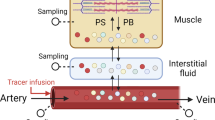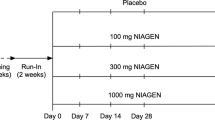Abstract
Objectives:
To measure uptake and disposal kinetics and absolute absorption of vitamin K1 using two stable isotope-labelled forms of vitamin K1.
Subjects:
Ten subjects (nine women and one man) aged between 22 and 31 years, with a mean (±standard deviation) body mass index of 22.5±2.4 kg/m2. Subjects took capsules containing 3 μg of methyl-13C vitamin K1, three times a day for six days to reach a steady state for plasma vitamin K1 isotopic enrichment. On day seven, subjects were given an intravenous dose of Konakion MM to measure disposal kinetics and at the same time, a capsule containing 4 μg of ring-D4 vitamin K1 to measure absorption. Plasma vitamin K1 concentration was measured by high-performance liquid chromatography and isotopic composition by gas chromatography mass spectrometry.
Results:
The disposal kinetics of the intravenous dose of vitamin K1 were resolved into two exponentials with half-times of 0.22 (±0.14) and 2.66 (±1.69) h. Absorption of oral, deuterated vitamin K1 was 13 (±9) %.
Conclusions:
Two-compartmental kinetic parameters observed in this study are similar to those obtained previously using radioactive tracers, but there may be additional slow-turnover body pools acting as stores of vitamin K1. The kinetic parameters determined from the intravenous dose allowed determination of the absolute absorption of vitamin K1 from a bolus oral dose.
This is a preview of subscription content, access via your institution
Access options
Subscribe to this journal
Receive 12 print issues and online access
$259.00 per year
only $21.58 per issue
Buy this article
- Purchase on Springer Link
- Instant access to full article PDF
Prices may be subject to local taxes which are calculated during checkout


Similar content being viewed by others
References
Berkner KL, Runge KW (2004). The physiology of vitamin K nutriture and vitamin K-dependent protein function in atherosclerosis. J Thromb Haemost 2, 2118–2132.
Binkley NC, Krueger DC, Engelke JA, Foley AL, Suttie JW (2000). Vitamin K supplementation reduces serum concentrations of under-γ-carboxylated osteocalcin in healthy young and elderly adults. Am J Clin Nutr 72, 1523–1528.
Binkley NC, Krueger DC, Kawahara TN, Engelke JA, Chappell RJ, Suttie JW (2002). A high phylloquinone intake is required to achieve maximal osteocalcin γ -carboxylation. Am J Clin Nutr 76, 1055–1060.
Bjornsson TD, Meffin PJ, Swezey SE, Blaschke TF (1979). Effects of clofibrate and warfarin alone and in combination on the disposition of vitamin K1 . J Pharmacol Exp Ther 210, 322–326.
Bluck LJC, Coward WA (1997). Peak measurement in gas chromatographic mass spectrometric isotope studies. J Mass Spectrom 32, 1212–1218.
Booth SL, Broe KE, Gagnon DR, Tucker KL, Hannan MT, McLean RR et al. (2003a). Vitamin K intake and bone mineral density in women and men. Am J Clin Nutr 77, 512–516.
Booth SL, Lichtenstein AH, Dallal GE (2002). Phylloquinone absorption from phylloquinone-fortified oil is greater than from a vegetable in younger and older men and women. J Nutr 132, 2609–2612.
Booth SL, Martini L, Peterson JW, Saltzman E, Dallal GE, Wood RJ (2003b). Dietary phylloquinone depletion and repletion in older women. J Nutr 133, 2565–2569.
Booth SL, O'Brien-Morse ME, Dallal GE, Davidson KW, Gundberg CM (1999). Response of vitamin K status to different intakes and sources of phylloquinone-rich foods: comparison of younger and older adults. Am J Clin Nutr 70, 368–377.
Booth SL, Tucker KL, Chen H, Hannan MT, Gagnon DR, Cupples LA et al. (2000). Dietary vitamin K intakes are associated with hip fracture but not with bone mineral density in elderly men and women. Am J Clin Nutr 71, 1201–1208.
Dainty JR (2001). Use of stable isotopes and mathematical modelling to investigate human mineral metabolism. Nutr Res Rev 14, 295–315.
Department of Health (1991). Dietary Reference Values for Food Energy and Nutrients for the United Kingdom. Report on Health and Social Subjects No. 41. HMSO: London.
Dolnikowski GG, Sun Z, Grusak MA, Peterson JW, Booth SL (2002). HPLC and GC/MS determination of deuterated vitamin K (phylloquinone) in human serum after ingestion of deuterium-labeled broccoli. J Nutr Biochem 13, 168–174.
Erkkilä AT, Lichtenstein AH, Dolnikowski GG, Grusak MA, Jalbert SM, Aquino KA et al. (2004). Plasma transport of vitamin K in men using deuterium-labeled collard greens. Metabolism 53, 215–221.
Feskanich D, Weber P, Willett WC, Rockett H, Booth SL, Colditz GA (1999). Vitamin K intake and hip fractures in women: a prospective study. Am J Clin Nutr 69, 74–79.
Garber AK, Binkley NC, Krueger DC, Suttie JW (1999). Comparison of phylloquinone bioavailability from food sources or a supplement in human subjects. J Nutr 129, 1201–1203.
Gijsbers BL, Jie KS, Vermeer C (1996). Effect of food composition on vitamin K absorption in human volunteers. Br J Nutr 76, 223–229.
Green PJ, Silverman BW (1994). Nonparametric regression and generalized linear models—a roughness penalty approach. Monographs on Statistics and Applied Probability 58, Chapman and Hall/CRC: London.
Hodges SJ, Bejui J, Leclercq M, Delmas PD (1993). Detection and measurement of vitamins K1 and K2 in human cortical and trabecular bone. J Bone Miner Res 8, 1005–1008.
Institute of Medicine (IOM) Food and Nutrition Board (2001). Dietary Reference Intakes for Vitamin A, Vitamin K, Arsenic, Boron, Chromium, Copper, Iodine, Iron, Manganese, Molybdenum, Nickel, Silicon, Vanadium, and Zinc. National Academy Press: Washington, DC.
Jeanes YM, Hall WL, Ellard S, Lee E, Lodge JK (2004). The absorption of vitamin E is influenced by the amount of fat in a meal and the food matrix. Br J Nutr 92, 575–579.
Jie KG, Bots ML, Vermeer C, Witteman JCM, Grobbee DE (1995). Vitamin K intake and osteocalcin levels in women with and without aortic atherosclerosis: a population-based study. Athersclerosis 116, 117–123.
Jones KS, Bluck LJC, Coward WA (2006). Analysis of isotope ratios in vitamin K1 (phylloquinone) from human plasma by gas chromatography mass spectrometry. Rapid Commun Mass Spectrom 20, 1894–1898.
Kurilich AC, Britz SJ, Clevidence BA, Novotny JA (2003). Isotopic labeling and LC-APCI-MS quantification for investigating absorption of carotenoids and phylloquinone from kale (Brassica oleracea). J Agric Food Chem 51, 4877–4883.
Lamon-Fava S, Sadowski JA, Davidson KW, O'Brien ME, McNamara JR, Schaefer EJ (1998). Plasma lipoproteins as carriers of phylloquinone (vitamin K1) in humans. Am J Clin Nutr 67, 1226–1231.
Matthews DE, Bier DM (1983). Stable isotope methods for nutritional investigation. Ann Rev Nutr 3, 309–339.
Neogi T, Booth SL, Zhang YQ, Jacques PF, Terkeltaub R, Aliabadi P et al. (2006). Low vitamin K status is associated with osteoarthritis in the hand and knee. Arthritis Rheum 54, 1255–1261.
Niemeier A, Kassem M, Toedter K, Wendt D, Ruether W, Beisiegel U et al. (2005). Expression of LRP1 by human osteoblasts: a mechanism for the delivery of lipoproteins and vitamin K1 to bone. J Bone Miner Res 20, 283–293.
Olson RE, Chao J, Graham D, Bates MW, Lewis JH (2002). Total body phylloquinone and its turnover in human subjects at two levels of vitamin K intake. Br J Nutr 87, 543–553.
Schurgers LJ, Dissel PE, Spronk HM, Soute BA, Dhore CR, Cleutjens JP et al. (2001). Role of vitamin K and vitamin K-dependent proteins in vascular calcification. Z Kardiol 90, III57–III63.
Schurgers LJ, Geleijnse JM, Grobbee DE, Pols HAP, Hofman A, Witteman JCM et al. (1999). Nutritional intake of vitamins K1 (phylloquinone) and K2 (menaquinone) in The Netherlands. J Nutr Env Med 9, 115–122.
Schurgers LJ, Vermeer C (2000). Determination of phylloquinone and menaquinones in food. Effect of food matrix on circulating vitamin K concentrations. Haemostasis 30, 298–307.
Schurgers LJ, Vermeer C (2002). Differential lipoprotein transport pathways of K-vitamins in healthy subjects. Biochim Biophys Acta 1570, 27–32.
Shearer MJ (1988). The assessment of human vitamin K status from tissue measurements. In: JW Suttie (ed). Current Advances in Vitamin K Research. Elsevier: New York. pp 437–452.
Shearer MJ, Barkhan P, Webster GR (1970). Absorption and excretion of an oral dose of tritiated vitamin K1 in man. Br J Haematol 18, 297–308.
Shearer MJ, Mallinson CN, Webster GR, Barkhan P (1972). Clearance from plasma and excretion in urine, faeces and bile of an intravenous dose of tritiated vitamin K1 in man. Br J Haematol 22, 579–588.
Shearer MJ, McBurney A, Barkhan P (1974). Studies on the absorption and metabolism of phylloquinone (vitamin K1) in man. Vitam Horm 32, 513–542.
Shepherd AMM, Wilson NM, Stevenson IH (1977). Vitamin K pharmacokinetics: response in young and elderly patients. Clin Pharmacol Ther 21, 117 (abstract).
Shipley RA, Clark RE (1972). Tracer Methods for In Vivo Kinetics—Theory and Applications. Academic Press: New York.
Soedirman JR, De Bruijn EA, Maes RA, Hanck A, Grüter J (1996). Pharmacokinetics and tolerance of intravenous and intramuscular phylloquinone (vitamin K1) mixed micelles formulation. Br J Clin Pharmacol 41, 517–523.
Stellaard F (2005). Use of dual isotope tracers in biomedical research. Isotopes Environ Health Stud 41, 275–286.
Suttie JW, Mummah-Schendel LL, Shah DV, Lyle BJ, Greger JL (1988). Vitamin K deficiency from dietary vitamin K restriction in humans. Am J Clin Nutr 47, 475–480.
Thane CW, Bolton-Smith C, Coward WA (2006). Comparative dietary intake and sources of phylloquinone (vitamin K1) in national samples of British adults from 1986–7 and 2000–1. Br J Nutr 96, 1105–1115.
Wang LY, Bates CJ, Yan L, Harrington DJ, Shearer MJ, Prentice A (2004). Determination of phylloquinone (vitamin K1) in plasma and serum by HPLC with fluorescence detection. Clin Chim Acta 347, 199–207.
Acknowledgements
We acknowledge the UK Food Standards Agency for funding this work (project number N05050) and thank Dr Martin Shearer for his helpful comments on the manuscript.
Author information
Authors and Affiliations
Corresponding author
Additional information
Contributors: KSJ, LJCB and WAC designed the study. KSJ was responsible for implementation, volunteer recruitment, sample collection and isotope ratio analysis. LYW performed the HPLC analysis. KSJ wrote the manuscript with LJCB and WAC.
Rights and permissions
About this article
Cite this article
Jones, K., Bluck, L., Wang, L. et al. A stable isotope method for the simultaneous measurement of vitamin K1 (phylloquinone) kinetics and absorption. Eur J Clin Nutr 62, 1273–1281 (2008). https://doi.org/10.1038/sj.ejcn.1602859
Received:
Revised:
Accepted:
Published:
Issue Date:
DOI: https://doi.org/10.1038/sj.ejcn.1602859
Keywords
This article is cited by
-
Association of vitamin K with cardiovascular events and all-cause mortality: a systematic review and meta-analysis
European Journal of Nutrition (2019)
-
VKORC1-dependent pharmacokinetics of intravenous and oral phylloquinone (vitamin K1) mixed micelles formulation
European Journal of Clinical Pharmacology (2013)



